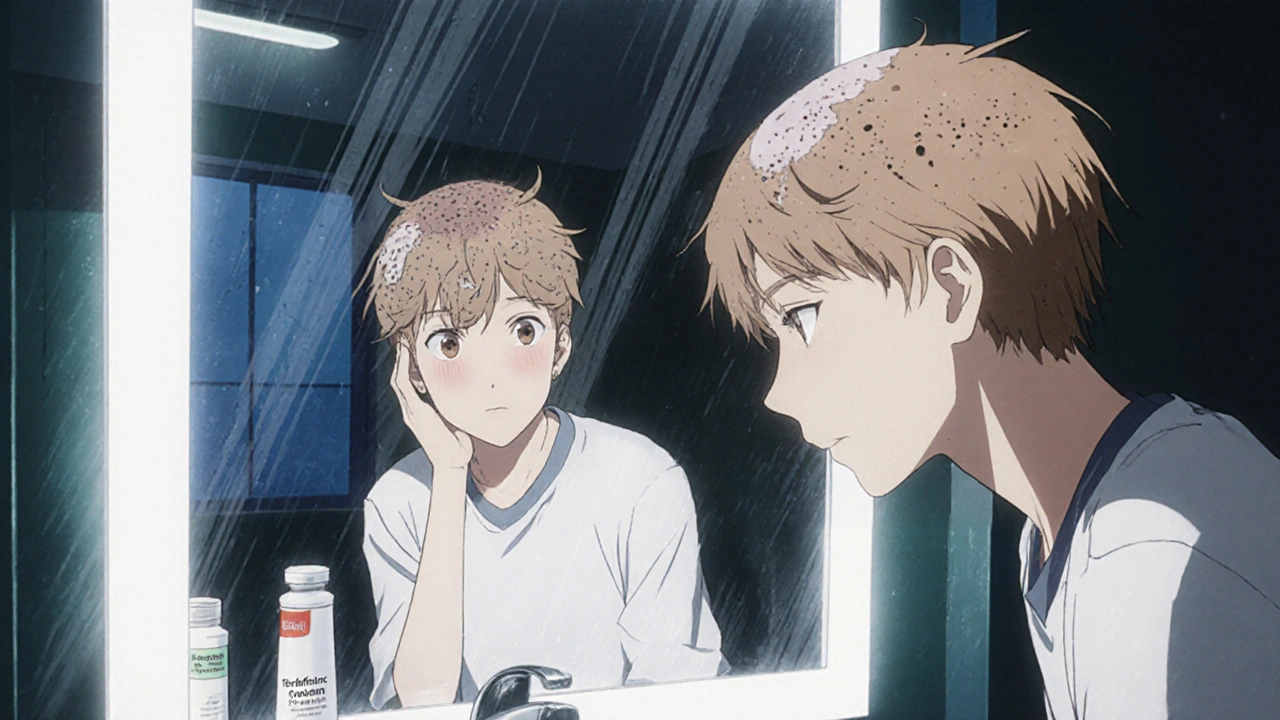Ringworm isn’t caused by a worm. That’s the first thing to know. The name is misleading, but the infection is real-and it’s common. Whether it shows up as a red, itchy circle on your arm, flaky skin between your toes, or a patch of baldness on your child’s scalp, ringworm is a fungal infection called tinea. It doesn’t care if you’re rich or poor, young or old. It thrives in warm, damp places-and it spreads easily. If you’ve ever had a rash that wouldn’t go away, no matter how much lotion you put on it, this is probably why.
What Exactly Is Ringworm?
Ringworm, or dermatophytosis, is caused by fungi called dermatophytes. These aren’t worms. They’re mold-like organisms that live on dead skin, hair, and nails. Three main types cause infections: Trichophyton, Microsporum, and Epidermophyton. They don’t burrow deep. They feed on the outer layers of your body, which is why they show up as rashes, flaking, or nail changes.
The classic sign? A red, circular rash with a raised, scaly border and a clearer center-like a ring. But not all cases look like this. Sometimes it’s just a red patch that itches. Other times, it’s cracked skin between the toes or thick, yellow toenails. The shape isn’t always perfect. The fungus doesn’t follow rules.
Types of Tinea and Where They Show Up
Tinea doesn’t have one face. It has many, depending on where it lands.
- Tinea corporis (body ringworm): The classic ring-shaped rash. Starts small-about half an inch-and spreads outward. Often appears on arms, legs, or face. It’s the most common type in adults and kids.
- Tinea pedis (athlete’s foot): This one lives in shoes. Between the toes, it causes peeling, burning, and sometimes blisters. It stinks. And it’s contagious. About 15% of all ringworm cases are this type.
- Tinea cruris (jock itch): Red, itchy patches on the inner thighs and groin. Sweating makes it worse. Men get it more often, but women can too.
- Tinea capitis (scalp ringworm): This one hits kids hardest. Bald spots appear, sometimes with black dots where hair broke off. In severe cases, a swollen, pus-filled lump called a kerion forms. Left untreated, it can scar the scalp permanently.
- Tinea unguium (nail fungus): Toenails thicken, turn yellow or brown, and become brittle. Fingernails rarely get it. Why? Feet are trapped in socks and shoes-perfect fungal condos.
Incubation time? Usually 4 to 14 days after exposure. But sometimes it takes up to three weeks before you notice anything. That’s why people think they caught it from the gym yesterday-when really, it was from a towel they used a week ago.
How Do You Catch It?
You don’t need to be dirty to get ringworm. You just need to be in the wrong place at the wrong time.
- Direct contact: Skin-to-skin contact with an infected person or pet. About 60% of cases happen this way.
- Shared items: Towels, combs, hats, sports gear, or even bedsheets. That’s 30% of cases.
- Animals: Cats and dogs are the most common carriers. A stray cat with a patchy coat? It could be spreading fungus without showing symptoms.
- Public spaces: Locker rooms, showers, swimming pools. If you walk barefoot, you’re risking it. Studies show skipping shoes in public showers increases your chance by 45%.
Some people are more at risk. Wrestlers? Up to 84% have had ringworm at some point. People who sweat a lot? Hyperhidrosis affects 3% of the population-and makes fungal growth easier. Veterinarians? 15-20% get infected because they’re around animals daily. Kids under 10? They make up 60% of scalp ringworm cases.
What Works: Antifungal Creams and Treatments
Most ringworm cases can be treated at home-with the right cream.
Topical antifungals are the first line of defense. They kill the fungus where it lives-on the skin’s surface. Here’s what works:
- Clotrimazole (1%): Found in brands like Lotrimin. Works in 70-80% of cases. Apply twice daily for 2-4 weeks.
- Miconazole (2%): Similar to clotrimazole. Slightly less effective but still reliable.
- Terbinafine (1%): Sold as Lamisil AT. Best performer. Works in 80-90% of cases. Often clears up in just 1-2 weeks. Users report visible improvement in 3-5 days.
- Ketoconazole (2%): Used for stubborn cases. Also found in some shampoos for scalp infections.
Why is terbinafine better? It doesn’t just stop the fungus from growing-it kills it. Others only slow it down. That’s why it works faster and has fewer recurrences.
But here’s the catch: You have to use it long enough. Most people stop when the rash looks gone. That’s a mistake. The fungus is still there, hiding under the skin. A 2023 Reddit thread with over 1,200 comments found that 68% of users quit treatment early-and 45% of them got it back.

When Creams Aren’t Enough
Topical treatments don’t work for everything. If the infection is on your scalp or nails, you need oral medicine.
For tinea capitis, doctors prescribe oral terbinafine (250mg daily for 4-6 weeks) or griseofulvin. Cure rates hit 85-90%. Without treatment, the infection can destroy hair follicles and leave permanent bald spots.
For nail fungus, terbinafine is also the go-to. But it takes months. Toenails grow slowly. You won’t see results until new, healthy nail grows out. Patience is required.
Oral antifungals can affect the liver. That’s why doctors test your liver enzymes before starting. Not everyone can take them. Pregnant women? Not an option. People with liver disease? Usually not either.
What Doesn’t Work (And Why)
Tea tree oil. Coconut oil. Vinegar soaks. These get promoted a lot online. But here’s the truth: a 2021 Cochrane Review found no strong evidence they work. They might soothe itching, but they don’t kill the fungus like clotrimazole or terbinafine do. One study showed only 40-50% clearance with tea tree oil-compared to 70-90% with pharmaceutical creams.
Same goes for “natural” antifungal supplements. No clinical trial backs them up for skin infections. If you’re spending money on these, you’re wasting it. Stick to what’s proven.
Prevention: How to Stop It Before It Starts
Ringworm is easy to catch. But it’s even easier to avoid.
- Wear flip-flops in public showers and locker rooms. Reduces risk by 45%.
- Change socks daily. Twice a day if you sweat a lot.
- Avoid sharing towels, hats, or hairbrushes. That cuts transmission by 30%.
- Keep skin dry. After showering, dry between your toes, under your breasts, and in your groin. Use a clean towel.
- Don’t touch stray animals with bald patches. If your pet has flaky skin, take them to the vet.
- Wash sports gear after every use. Wrestling mats, helmets, and uniforms are hotspots.
Parents: Check your kids’ scalps weekly. If you see a scaly patch or hair breaking off, see a doctor fast. Early treatment stops scarring.

What Happens If You Ignore It?
Ringworm won’t just go away. It spreads. Untreated, it can cover 30-50% more skin in two weeks. It can spread to your nails, your scalp, even your hands.
For kids with scalp ringworm, delays mean permanent hair loss. For adults with nail fungus, it gets worse over time-thicker, darker, harder to treat. And if you’re immunocompromised? Your body can’t fight it. Treatment failure rates are 3.5 times higher. What starts as a small rash can become a serious infection.
And then there’s the social side. A 2022 Kids Health survey found 73% of teens with visible ringworm were bullied or avoided by peers. It’s not just a health issue-it’s a stigma.
Cost and Accessibility
Good news: Most antifungal creams cost $5 to $15. You don’t need a prescription. You can buy them at any pharmacy or grocery store.
Terbinafine cream (Lamisil AT) averages $8.75 per tube, according to GoodRx. Oral medications? Prescription-only. Terbinafine pills cost $25-$150, depending on insurance. But they’re often covered.
In the U.S., ringworm causes about $500 million in medical costs each year. That’s mostly from missed school, doctor visits, and repeated treatments because people didn’t finish their cream.
Emerging Problems: Resistance Is Growing
There’s a quiet threat: antifungal resistance. A 2022 study in the Journal of the American Academy of Dermatology found a 12% increase in terbinafine-resistant strains of Trichophyton between 2018 and 2022. That means some infections won’t respond to the most effective cream anymore.
Why? Overuse. Misuse. Stopping treatment early. Using weak products. These habits let the strongest fungi survive-and multiply.
Doctors are starting to see cases that need longer treatment or stronger drugs. If you’ve tried terbinafine twice and it didn’t work? It might not be your fault. The fungus changed.
When to See a Doctor
You can treat most cases at home. But call a doctor if:
- The rash doesn’t improve after 2 weeks of treatment
- It spreads to your scalp or nails
- You have a kerion (swollen, pus-filled lump)
- You’re diabetic, pregnant, or have a weak immune system
- You’re not sure it’s ringworm
Doctors can do a skin scraping and look under a microscope. It takes 5 minutes. It tells you for sure if it’s fungus-and what kind.
Is ringworm contagious?
Yes, ringworm is highly contagious. It spreads through direct skin contact, shared items like towels or clothing, and contact with infected animals. You can catch it from walking barefoot in a public shower or using a gym mat someone else used.
Can you get ringworm from your pet?
Absolutely. Cats and dogs are common carriers, even if they don’t show obvious signs. Look for patches of missing fur, scaly skin, or excessive scratching. If your pet has these symptoms, take them to the vet-and wash your hands after touching them.
How long does it take for antifungal cream to work?
You’ll usually see improvement in 3 to 7 days, especially with terbinafine. But the infection isn’t gone. You need to keep applying the cream for 2 to 4 weeks, even if the rash looks gone. Stopping early is the #1 reason ringworm comes back.
Can ringworm cause permanent damage?
Yes, especially on the scalp. If tinea capitis isn’t treated early, it can lead to scarring and permanent hair loss. Nail infections can permanently thicken and discolor nails. The earlier you treat it, the less risk there is.
Are natural remedies like tea tree oil effective?
No. While tea tree oil may soothe itching, studies show it clears ringworm in only 40-50% of cases. Prescription and over-the-counter antifungal creams like terbinafine and clotrimazole clear it in 70-90%. Natural options aren’t reliable enough to treat the infection properly.
Why does ringworm come back?
It usually comes back because treatment was stopped too soon. Fungus hides under the skin-even when the rash looks gone. Other reasons: not cleaning shared items, wearing damp socks, or re-exposure from an infected pet or person.
Ringworm isn’t a sign of poor hygiene. It’s a sign that fungus is everywhere-and it’s good at hiding. The key isn’t fear. It’s awareness. Use the right cream. Finish the course. Don’t share towels. Keep skin dry. That’s all it takes to stop it in its tracks.








Emily Craig November 25, 2025
So I used clotrimazole for two weeks and it looked fine so I stopped… then boom it came back worse and my roommate thought I was contagious so she moved out 😭
Turns out I’m the human version of a fungal disco ball
Arup Kuri November 26, 2025
They don't want you to know this but antifungal creams are just a front for Big Pharma
Tea tree oil has been used for 5000 years in India and still works better than their chemically engineered poison
They make you buy it again and again because they profit off your ignorance
Kimberley Chronicle November 26, 2025
Interesting breakdown on dermatophyte taxonomy and topical efficacy profiles
Terbinafine’s fungicidal mechanism via squalene epoxidase inhibition is clinically superior to fungistatic azoles like clotrimazole
That said, adherence remains the critical variable-compliance rates under 35% in real-world settings explain recurrence patterns
Also worth noting: biofilm formation on nail keratin may reduce penetration, necessitating longer courses for onychomycosis
Dolapo Eniola November 27, 2025
Why you all wasting money on creams when in Nigeria we just use neem leaves boiled in water and wash twice a day
My cousin had scalp ringworm and we cured it in 10 days with nothing but nature
Western medicine is just selling you fear and pills 😎
God made plants first not chemists
Pallab Dasgupta November 29, 2025
Bro I had jock itch so bad I couldn’t sit down for three weeks
Terbinafine saved me like a damn superhero
Applied it before bed, woke up like ‘whoa my balls don’t feel like they’re on fire’
But yeah I stopped after 10 days because it looked fine
Then it came back like a horror movie sequel
Now I’m on week 5 and I’m not touching my socks with my bare hands ever again
Also if your dog looks like a zombie cat, take it to the vet. It’s not just shedding
Ellen Sales December 1, 2025
I used to think ringworm was just a rash… until I saw my daughter’s scalp…
One day she had a tiny patch… the next… nothing
Not even hair… just… smooth skin… like it was erased
And I didn’t know what was happening
Until the doctor said ‘tinea capitis’ and I cried in the parking lot
We did six weeks of oral terbinafine… it was scary… but we did it
Now she’s got a little fuzz growing back
And I never let her borrow a hat again
And I wash everything… everything… every single thing
Because I learned… it doesn’t care how clean you are
It just wants a warm place to hide
Erika Hunt December 3, 2025
It's fascinating how the social stigma surrounding ringworm intersects with public health messaging, particularly in adolescent populations where visible dermatological conditions can trigger social exclusion and psychological distress, as referenced in the 2022 Kids Health survey-this suggests that medical interventions alone are insufficient without concurrent educational campaigns aimed at destigmatizing fungal infections as common, non-judgmental biological occurrences rather than indicators of poor hygiene or personal failure, and perhaps schools should implement routine screenings for scalp ringworm in elementary grades given the high prevalence and irreversible consequences of delayed treatment, especially in communal settings like locker rooms and sleepovers where transmission is often asymptomatic and undetected
Roscoe Howard December 3, 2025
While the article presents a clinically accurate overview of dermatophytosis, it is noteworthy that the overwhelming reliance on topical antifungal agents reflects a systemic failure in public health infrastructure to prioritize prophylactic hygiene education and environmental decontamination protocols. The normalization of self-treatment without medical consultation, particularly among younger demographics, represents a dangerous erosion of evidence-based medical adherence. Furthermore, the casual dismissal of natural remedies as ineffective, while statistically valid, fails to acknowledge the cultural and psychological dimensions of patient autonomy. In an era of increasing antimicrobial resistance, a more robust, multidisciplinary approach-integrating dermatology, epidemiology, and behavioral psychology-is imperative to mitigate recurrence and societal stigma. The $500 million annual cost is not merely a fiscal concern; it is a moral indictment of our healthcare system’s prioritization of profit over prevention.